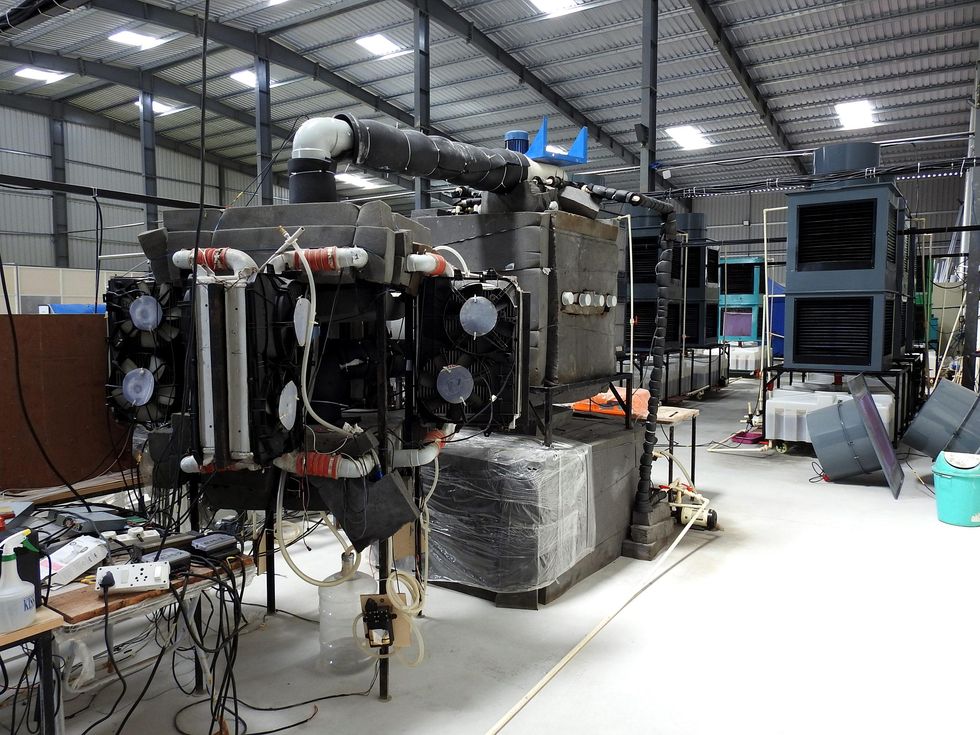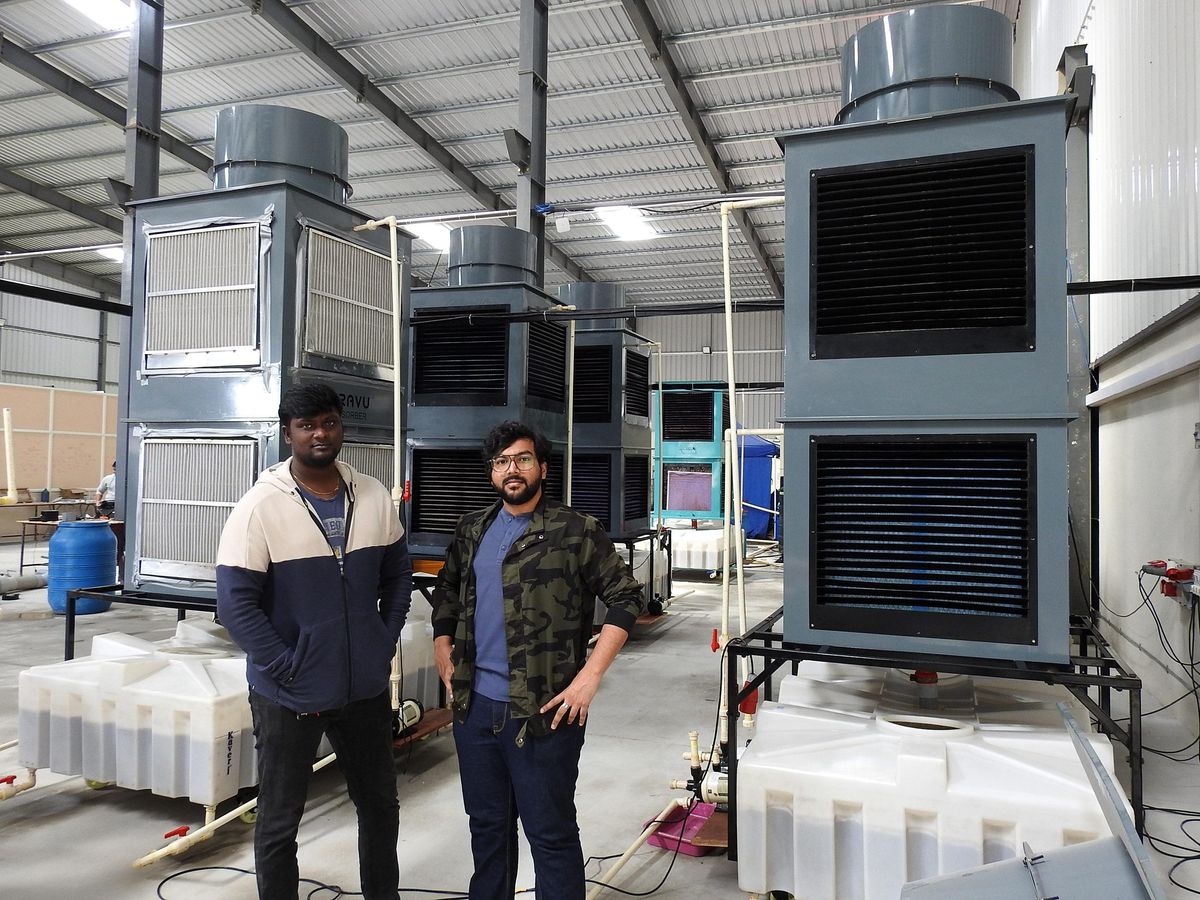BENGALURU, India—Technology that can pull water out of thin air could help solve the world’s growing water scarcity problem, but most solutions are expensive and difficult to scale. Indian startup Uravu Labs says its low-cost modular approach could provide a blueprint for more affordable and sustainable atmospheric water harvesting. What comes out of the pipe, the company’s website says, is “100 percent renewable water”—renewably powered, harnessed from a vast and nearly inexhaustible source, and with no wastewater produced in the process.
Uravu is putting the finishing touches on its biggest unit to date. The device, the company says, will be capable of harvesting up to 1,000 liters of water a day when it goes online later this month, at its headquarters in the south Indian city of Bengaluru. By the end of the year the company hopes to scale that up to 10,000 L a day, says cofounder Swapnil Shrivastav.
Uravu isn’t the only company working on this problem, but its approach is different from that of most of its competitors. The vast majority of companies working in this area rely on technology similar to that found in air-conditioning units—a coiled tube full of refrigerant is used to cool air until its moisture condenses on the surface as liquid water.
However, the approach requires huge amounts of electricity, says Shrivastav, and this makes these units expensive to run and unsustainable unless specifically powered by renewable energy. “Our goal from day one was to not only be scalable and renewable but also be the most affordable,” he says.
This led Uravu to a solution that relies on water-loving materials called desiccants to absorb moisture from the air, which are then heated using renewable-energy sources to release the water again. The team started work on the idea in 2017 and made it to the finals of the Water Abundance XPrize, a two-year competition organized by XPrize to catalyze progress in atmospheric water-harvesting technology.
Since then Uravu has raised US $2.5 million and completely revamped its design. Initially, the company was working on a self-contained unit about 4 meters across that combined a solid desiccant called silica gel with a solar thermal panel, which uses the sun to warm up water that can then be used to heat the desiccant. This could produce about 10 L of water a day, but because each unit required dedicated components like fans, valves, and pumps, the company found it got very little cost reductions when it tried to scale up, says Shrivastav.
That’s why Uravu has now switched to a new design that decouples the key stages involved in harvesting water from air. One key step involved swapping out the silica gel for a liquid desiccant—calcium chloride solution—which is pumped between dedicated absorber and desorber units. In the absorber units the desiccant is sprinkled through a mesh to increase the surface area as air is drawn over it by a fan. After it absorbs moisture from the air, the desiccant is pumped to a separate desorber unit where the solution is heated to between 60 and 70 °C by a coiled pipe filled with hot water. This creates air so humid it’s almost like steam, which then passes to a low-power, air-cooled condenser that turns it into liquid water.
Decoupling the absorber and desorber leads to significant scaling efficiencies, says Shrivastav, since each desorber can serve several of the less complicated absorbers. Each absorber unit is capable of collecting as much as 200 L per day. To create Uravu’s 1,000-L-per-day machine, the company will couple six absorbers with a single desorber unit. The new design can now use a variety of heat sources, including solar thermal panels, biomass burners, or industrial waste heat. If working with solar thermal power, the design also incorporates a hot water tank that acts as a thermal battery, allowing it to run even when the sun goes down.
The company’s approach, says Shrivastav, uses roughly 40 percent less power than more conventional condensing systems to produce the same number of liters per day. The output of condensing systems also varies considerably depending on the local humidity, whereas Uravu can simply load more desiccant into its absorber when operating in drier areas to achieve the same level of output, he adds.

One area where Uravu’s system doesn’t match up favorably is its physical footprint. A condensing system that fits in a shipping container can produce 6,000 L per day, but in the near term the company is unlikely to get more than 2,000 L out of a system that size, Shrivastav says. While the system may not be as compact, its much lower operating costs mean the company can already produce water for about 6 U.S. cents a liter, which is about 40 percent lower than a typical condensing system. Uravu expects that to come down to 3 cents in the near future, Shrivastav says.
One problem with these kinds of large water-harvesting units, however, is that they require a large up-front investment, says Chiara Neto, a professor of physical chemistry at the University of Sydney, in Australia. That may put them out of reach for many poorer communities most in danger of water scarcity.
And while it may be cheaper than other air-to-water approaches, Uravu still can’t compete with water from conventional sources, which is typically below 1 cent per liter in India. The math is more favorable in other geographies with more expensive water, says Shrivastav, such as the Middle East and Australia. But closer to home, the company has had to explore some novel business models that involve people paying a premium to burnish their environmental credentials.
Uravu is currently providing renewable drinking water in reusable glass bottles to high-end restaurants and hotel chains in Bengaluru. Shrivastav says the company’s aim is to compete with premium mineral waters that sell at a higher margin than standard drinking water. Uravu has also installed one of its units at India’s third largest distiller, Radico Khaitan, which plans to use its water in high-end spirits as a marketing ploy.
Shirvastav is also hopeful that NGOs or government organizations may help subsidize some of the cost of Uravu’s units, based on their knock-on benefits. Because they don’t rely on natural water sources, the units can be set up anywhere, which could help tackle the social cost to women and children who have to travel miles every day to collect water. And in India, which has a growing groundwater-depletion crisis, they could replace reverse osmosis plants that waste as much as 4 L of water for every liter of drinking water they produce.
Ultimately, though, for this kind of absorption-based water harvesting to become widely practical there needs to be some kind of breakthrough in desiccant technology, says Swee Ching Tan, an assistant professor of materials science and engineering at the National University of Singapore. While he understands that Uravu is likely using calcium chloride due to its low cost and easy availability, for the approach to become economically viable it requires desiccants that can hold much more water and release it at lower temperatures. “We need material science to make more effective, efficient materials,” Tan says.
Shrivastav says Uravu’s design is agnostic about what desiccant is used, as long as it’s soluble, and so the company should be able to work with new ones as they become available. But he points out that new materials typically take 8 to 12 years to reach commercialization. So waiting for better desiccants isn’t an option. And ultimately, even if Uravu’s costs limit where the technology can be applied, it could still make a significant difference.
“We want to reach around 1 million liters per day in the next five years,” he says. “That translates to saving more than 2.5 million liters of groundwater and more than 15 to 20 tonnes of CO2.”
This article appears in the April 2023 print issue as “Air, the New Freshwater Source.”
Update 14 Feb. 2023: Uravu reports they’ve raised $2.5 million in funding, not the $4.5 million Spectrum originally reported. Spectrum regrets the error.
- Could Pulling Water from Air Slake Global Thirst? ›
- Solar-Powered Device Pulls Water Out of Thin (and Pretty Dry) Air ›
- A New Energy-Efficient Hydrogel Pulls Water From Air - IEEE Spectrum ›
Edd Gent is a freelance science and technology writer based in Bengaluru, India. His writing focuses on emerging technologies across computing, engineering, energy and bioscience. He's on Twitter at @EddytheGent and email at edd dot gent at outlook dot com. His PGP fingerprint is ABB8 6BB3 3E69 C4A7 EC91 611B 5C12 193D 5DFC C01B. His public key is here. DM for Signal info.



